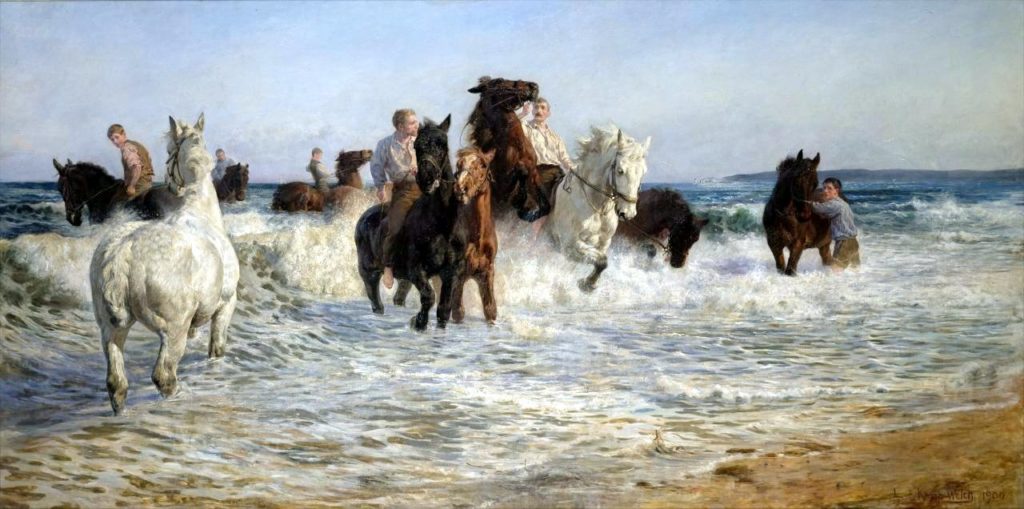Choosing and arranging words according to their sound can intensify meaning and create rhythm in a sentence; the degree of musicality you employ will depend on the intended mood and tone of your writing. In Geraldine Brooks’ ‘Year of Wonders’ (2001), Part 1 is called ‘Leaf-Fall, 1666’. Readers’ senses are immediately stimulated as autumnal sights, sounds and smells are richly evoked; there is an undercurrent of the foreshadowing of tragedy, decay and death. Chapter 1 is called ‘Apple-picking time’ and the reader can hear the ripened apples tumbling into bins; smell the hay, the sap of the forest, rotting apples and wet wood; and see the golden autumnal light as the sun slips towards the horizon in the late afternoon. Anna, the first-person narrator, tells us:
I used to love this season. The wood stacked by the door, the tang of its sap still speaking of forest. The hay made, all golden in the low afternoon light. The rumble of the apples tumbling into the cellar bins. . . thick, sweet scents of rotting apple and wet wood.
Sounds, smells, taste: this is sensory writing about the joys of nature by the narrator whose voice engages immediately with the reader. Not only does Brooks paint an image in words— The hay made, all golden in the low afternoon light, bringing to mind the ‘Haystacks’ series by French Impressionist painter, Claude Monet—but a musicality is captured in the sounds of the words: we can hear the “rumble” of apples “tumbling” into the bins … we can taste the “tang” of the “sap still speaking of forest”, which cleverly utilises the literary device of alliteration.
For Anna, her English village was far more than a physical space to be inhabited; she shares her lucid memory of the joys of nature, of birth, of death and the changing of the seasons. At the end of the novel, Anna chooses to leave England and make a new life for herself and her young daughters. She sails to the Middle East, far-removed from the dark, dank place of slow-death that was her home, to an exotic country exploding with life, bright light, intense heat, aromatic spices and vivid, glowing colour.
And then one morning I awoke to a smooth sea and warm air spiced with cardamom. I gathered up the baby and went on deck. I will never forget the dazzle of the sunlight, glinting off the white walls and the golden domes, or the way the city spilled down the mountain and embraced its wide blue harbour.
When I read the first page of a novel, or a manuscript (fiction or memoir) that I’ve been asked to assess, I want my senses to be immediately engaged and on alert. There may be intrigue, which grabs my attention, but I also want a hit to my senses, and immersion in the setting. In her memoir, Foreign Correspondence (1997), Geraldine Brooks begins:
It is a hot spring day and I am in the basement of my parents’ house in Sydney, sorting through tea chests. Pine floorboards creak above my head as my mother steps beside my father’s bed, checking his breathing mask.
The reader is drawn into her world: feels (the heat), hears (floorboards creaking) and sees (a cluttered basement) what the author shares about her memory of the past. I can even smell the pine . . .
George Eliot (Mary Ann Evans) describes a romantic, green and gentle place in the first long paragraph of ‘The Mill on the Floss’ (1860) that evokes the comfort of a living companion with a low, placid voice:
A wide plain, where the broadening Floss hurries on between its green banks to the sea, and the loving tide, rushing to meet it, checks its passage with an impetuous embrace . . . It seems to me like a living companion . . . while I wander along the bank and listen to its low, placid voice . . .
In Charles Dickens’ ‘Great Expectations’ (1861), Pip describes a bleak, less friendly place in the first few lines:
Ours was the marsh country, down by the river, within, as the river wound, twenty miles of the sea . . . the dark flat wilderness beyond the churchyard, intersected with dykes and mounds and gates . . . the low leaden line beyond the river . . . the distant savage lair from which the wind was rushing, was the sea
The alliteration in “low, leaden line” combines with words such as “dark”, “flat”, “distant”, and “savage” to evoke a sense of desolation, isolation, and primordial savagery that is sure to reflect some of the personalities of the characters.
The repetitive ‘b’ sounds in the famous last sentence of F. Scott Fitzgerald’s ‘The Great Gatsby’ (1925) capture the essence of the cycle of life: So we beat on, boats against the current, borne back ceaselessly into the past.
Here are three other alliterations that I have gathered throughout the time that I have been assessing manuscripts:
The sun slings spears, white and sharp as barra bone.
the morning mist shrouded the men as they scrambled and slipped over stones across the swirling stream.
The thunderous waterfall plummeted down, pounding the rocks . . .
Using alliteration and dynamic verbs in your writing, such as ‘plummeted’ and ‘pounding’ in the sentence above, intensifies readers’ vision and what they hear. However, like any writing tool, alliteration can be abused (she sells seashells by the seashore) and the effect ends up being laughable. Grumpy word-watcher, Simon Heffer, warns that too much alliteration in one’s writing can “detract from the sense of what is being written”. He appreciates its poetic use especially when applied by masterful writers such as Shakespeare—“sessions of sweet silent thought”. Alliteration can be used to great effect, but be careful not to overuse it.
We all write down our thoughts and ideas or what we want to communicate with a sense of urgency. Whether you’re writing a short story, a review, an essay, an email or a speech, it’s important to read back over what you’ve written and edit. If you really want to pack a punch in a particular sentence then first decide what tone you want to convey before choosing your words, taking time to listen to the actual sound of the words. When I am editing fiction, I sometimes suggest changing a few words or the length of sentences to help create more of an exciting, less plodding, rhythm. If you work at it you’ll develop your own brand of musicality—your own voice—that gives life to your writing.
As previously mentioned, strong verbs enliven the narrative with sound, movement and emotion. Peter Carey builds tension, atmosphere and personality through the verbs in this passage:
Maggs’s inky shadow flooded the crib. He leaned very close, so close indeed he might have bitten the child. Instead, he brought his wide nostrils almost up against that soapy skin and, with his arms clenched behind his back, inhaled John Marshall Oates’s breath. (‘Jack Maggs’)
Describing a room in which a scene is enacted can enhance the mood and reflect the mental and physical state of the characters. In Dickens’ ‘Bleak House’ (1852-53), there are a great number of broken-down interiors. The Jellyby household is “nothing but bills, dirt, waste, noise, tumbles downstairs, confusion, and wretchedness”. The “dusty bundles of papers” in Richard Carstone’s room seems to Esther “like dusty mirrors reflecting his own mind”.
Of course, it’s easy to become obsessed with the musicality of prose; but writers with an ear for rhythm can turn a mediocre piece of writing into a sharper one just by asking themselves if they can improve the sound of their sentences. All you have to do is listen in your head as you write or, better still, read out loud. If you listen well to the sound of words as they flow together, and learn to substitute words if necessary to improve rhythm, then you will produce better writing. Read and write with your senses: keep your eyes and ears alert.
To me, the greatest pleasure of writing is not what it’s about, but the inner music that words make. (Truman Capote, 1924-1984, author of ‘In Cold Blood’)
The formation of a word from a sound associated with the thing it describes is known as onomatopoeia; the related adjective is onomatopoeic. Examples of this type of word include atishoo, cuckoo, croak, hiccup, miaow, ping-pong, splash, and sizzle. As these examples indicate, there is a variety of sounds that are ‘translated’ into human speech using onomatopoeias: from human exclamations and machinery, to physical and natural phenomena such as the sounds animals make. The word onomatopoeia itself derives from Greek and came into the English language via Latin in the 16th century. It literally means ‘word-making’ (from the Greek onoma, onomat = name and –poios = making). Oxford Dictionary
This article enhances an article I wrote a few years ago about the evocation of place.
 Manuscript Assessment
Manuscript Assessment
If you’re ready to have an appraisal of your writing, whether it is a complete manuscript or a work-in-progress, then please email me via my contact page with a brief overview of your needs and I will give you an idea of the type of personalised service/s I can offer that I think would best suit you at this stage in your writing project (mentoring, manuscript appraisal, editing, proofreading).
Featured Photo: Villa Lante just north of Rome taken by the author in January 2009





